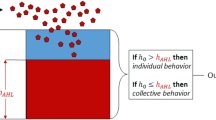Abstract
Bacterial populations meet the challenges of dynamic spatially heterogeneous environments with fluctuating biotic and abiotic factors in a number of ways. The motivation for the work presented here has been to transfer ideas from bacterial adaptability and evolvability to computational problem solving. Following a brief comment on some examples of the ways bacteria solve problems, a bacterially-inspired computational architecture for simulating aspects of problem solving is described. We then examine three case studies. The first, a study of the mutational impact of a remediation to toxic (fitness-reducing) material, highlights how a sufficiently pre-engineered adaptive system can solve a difficult problem quite easily. The second study looks at why it is difficult to evolve complex problem solving behaviours and how artificial selection mechanisms coupled with pre-engineering the system can help. Specifically, this refers to quorum sensing and tactic behaviours. A further study looked at ways in which a quorum sensing analogue could help computational agents find multiple peaks in a landscape. The paper concludes with a discussion of an investigation of bacteria that had both quorum sensing and tactic capabilities.
Similar content being viewed by others
References
G Alexandre S Greer-Phillips IB Zhulin (2004) ArticleTitleEcological role of energy taxis in microorganisms FEMS Microbiological Reviews 28 113–126
S Belkin (2003) ArticleTitleMicrobial whole-cell sensing systems of environmental pollutants. Current Opinion in Microbiology 6 206–212 Occurrence Handle10.1016/S1369-5274(03)00059-6
A Bonarini (2000) An introduction to learning fuzzy classifier systems W Lanzi PL Stolzman SW Wilson (Eds) Lecture Notes in Computer Science 1813. Springer-Verlag Berlin 83–106
UT Bornscheuer M Pohl (2001) ArticleTitleImproved biocatalysts by directed evolution and rational protein design Current Opinion in Chemical Biology 5 137–143 Occurrence Handle10.1016/S1367-5931(00)00182-4
AT Bull AC Ward M Goodfellow (2000) ArticleTitleSearch and discovery strategies for biotechnology: the paradigm shift Microbiology and Molecular Biology Reviews 64 573–606 Occurrence Handle10.1128/MMBR.64.3.573-606.2000
Z Chen D Govender R Gross R. Birge (1995) ArticleTitleAdvances in protein-based three-dimensional optical memories BioSystems 35 145–151 Occurrence Handle10.1016/0303-2647(94)01503-Y
TP Curtis WT Sloan JW Scannell (2002) ArticleTitleEstimating prokaryotic diversity and its limits Proceedings of the National Academy of Sciences of the USA 99 10494–10499 Occurrence Handle10.1073/pnas.142680199
Devine P and Paton RC (1997) Biologically-Inspired Computational Ecologies: A Case Study. Lecture Notes in Computer Science 1305 Corne D and Shapiro JL (eds) Springer-Verlag 11–30
MA Dollard P Billard (2003) ArticleTitleWhole-cell bacterial sensors for the monitoring of phosphate bioavailability Journal of Microbiological Methods 55 221–229 Occurrence Handle10.1016/S0167-7012(03)00164-7
R Gregory JR Saunders QH Wu (2004) ArticleTitleParallelising a model of bacterial interaction and evolution Bio Systems 76 121–131
JH Holland (1992) Adaptation in Natural and Artificial Systems: An Introductory Analysis with Applications to Biology Control and Artificial Intelligence Bradford/MIT Press MA
PT Hraber T Jones S Forrest (1997) ArticleTitleThe Ecology of Echo Artificial Life 3 165–190
Y Kuang I Biran DR Walt (2004) ArticleTitleLiving bacterial cell array for genotoxin monitoring Analytical Chemistry 76 2902–2909
MO Magnasco DS Thaler (1996) ArticleTitleChanging the pace of evolution Physics Letters A 221 287–292 Occurrence Handle10.1016/0375-9601(96)00599-3 Occurrence Handle97d:92006
EH Mamdani S Assilian (1975) ArticleTitleAn experiment in linguistic synthesis with a fuzzy logic controller International Journal of Man-Machine Studies 7 1–13
O Matoba B Javidi (2004) ArticleTitleSecure holographic memory by double-random polarization encryption Applied Optics 43 2915–2919
MB Miller BL Bassler (2001) ArticleTitleQuorum sensing in bacteria Annual Review of Microbiology 55 165–199 Occurrence Handle10.1146/annurev.micro.55.1.165
RC Paton (1997) ArticleTitleThe organisations of hereditary information BioSystems. 40 245–255 Occurrence Handle10.1016/S0303-2647(96)01652-8
RC Paton HS Nwana MJR Shave TJM Bench-Capon S Hughes (1991) Transfer of natural metaphors to parallel problem solving applications H-P Schwefel R Maenner (Eds) Parallel Problem Solving from Nature Lecture Notes in Computer Science. Springer-Verlag Berlin 363–372
RC Paton R Gregory C Vlachos JR Saunders QH Wu (2004) ArticleTitleEvolvable Social Agents for Bacterial Systems Modelling IEEE Transactions on Nanobioscience 3 208–216 Occurrence Handle10.1109/TNB.2004.833701
JA Shapiro (1997) ArticleTitleGenome organization, natural genetic engineering and adaptive mutation Trends in Genetics 13 98–104 Occurrence Handle10.1016/S0168-9525(97)01058-5
K Smalla PA Sobecky (2002) ArticleTitleThe prevalence and diversity of mobile genetic elements in bacterial communities of different environmental habitats: insights gained from different methodological approaches FEMS Microbiology Ecology 42 165–175
PS Stewart JW Costerton (2001) ArticleTitleAntibiotic resistance of bacteria in biofilms Lancet 358 135–138
PK Stoodley K Sauer DG Davies JW Costerton (2002) ArticleTitleBiofilms and complex differentiated communities Annual Review of Microbiology 56 187–209 Occurrence Handle10.1146/annurev.micro.56.012302.160705
DS Thaler (1994) ArticleTitleThe evolution of genetic intelligence Science 264 224–225
C Vlachos R Gregory RC Paton JR Saunders QH Wu (2003) ArticleTitleIndividual-based modelling of bacterial ecologies and evolution. Comparative and Functional Genomics 5 100–104
Author information
Authors and Affiliations
Corresponding author
Rights and permissions
About this article
Cite this article
Paton, R.C., Vlachos, C., Wu, Q.H. et al. Simulated Bacterially-Inspired Problem Solving – The Behavioural Domain. Nat Comput 5, 43–65 (2006). https://doi.org/10.1007/s11047-005-5498-x
Issue Date:
DOI: https://doi.org/10.1007/s11047-005-5498-x




